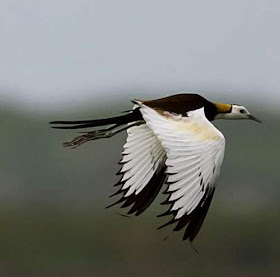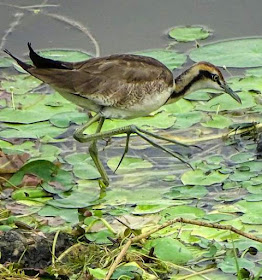Taxonomic classification <> Photos
The pheasant-tailed jacana (Hydrophasianus chirurgus) belongs to the family Jacanidae under the order Charadriiformes.
Parental care in Hydrophasianus chirurgus
The species under the family Jacanidae are a group of waders adapted for life on floating and emergent vegetation. They have long feets and toes which enable them to walk on floating vegetation.The long toes splay nearly 15 cm across in the case of H. chirurgus. This spreads the weight of the bird over greater surface area and prevents the vegetation giving way beneath it.
The males take up the responsibility of incubating the eggs. The species Hydrophasianus chirurgus are polyandrous. The pheasant-tailed jacana female builds a flimsy nest, lays four eggs and leaves it for the current mate to incubate.
After a few days the same female pairs up with another male and lays another clutch for the second male to incubate. In a breeding season these birds are known to lay even up to ten clutches. The female does not take part in incubation and raising of the young.
The male appears to be neglectful in the first ten days of incubation and nearly half of pheasant-tailed jacana nests are lost before the chick hatch out. The male birds have been observed to throw out some eggs from their nest for unknown reasons.
However, in the last week of incubation the male appears to be more responsible with incubation. Once the chicks hatch out the male becomes a better father. When threatened it may scoop the chicks under the wing and run for safety. Sometimes the male leads the chicks away from the danger.
| Taxonomic classification | |
|---|---|
| Binomial name: | Hydrophasianus chirurgus |
| Species: | H. chirurgus |
| Genus: | Hydrophasianus |
| Subfamily: | - |
| Family: | Jacanidae |
| Order: | Charadriiformes |
| Class: | Aves |
| Phylum: | Chordata |
| Kingdom: | Animalia |
 |
| 1.Pheasant-tailed jacana - Hydrophasianus chirurgus Photo by Ramjeesk |
 |
| 2.Pheasant-tailed jacana - Hydrophasianus chirurgus Photo by Karunakanth |
 |
| 3.Pheasant-tailed jacana (Hydrophasianus chirurgus) Photo by Karunakanth |
 |
| 4.Pheasant-tailed jacana (Hydrophasianus chirurgus) Photo by PJeganathan |
 |
| 5.Pheasant-tailed jacana (Hydrophasianus chirurgus) Photo by PJeganathan |
 |
| 6.Hydrophasianus chirurgus Photo by Sarala Gamage |
 |
| 7.Hydrophasianus chirurgus Photo by jinchin lin |
 |
| 8.Hydrophasianus chirurgus Photo by Sanjeev Jassal |
 |
| 9.Hydrophasianus chirurgus Photo by Tsrawal |
 |
| 10.Hydrophasianus chirurgus Photo by Arun.arunb |
1.Photo source: https://commons.wikimedia.org/wiki/File:Its_busy_time.jpg (cropped)
Photo author: Ramjeesk | License: CC BY-SA 4.0
2.Photo source: https://commons.wikimedia.org/wiki/File:Pheasant-tailed_Jacana*.jpg (cropped)
Author: Karunakanth | License: CC BY-SA 4.0
3.Photo source: https://commons.wikimedia.org/ (cropped)
Author: Karunakanth | License: CC BY-SA 4.0
4.Photo source: https://commons.wikimedia.org/wiki/File:Pheasant-tailed_jacana_(Hydrophasianus_chirurgus)_from_Aranthangi_JEG3996.jpg (cropped)
Author: PJeganathan | License: CC BY-SA 4.0
5.Photo source: https://commons.wikimedia.org (cropped)
Author: PJeganathan | License: CC BY-SA 4.0
6.Photo source: https://commons.wikimedia.org/wiki/File:Pheasant-tailed_jacana.jpg (cropped)
Author: Sarala Gamage | License: CC BY-SA 4.0
7.Photo source: https://www.flickr.com/photos/jinchinlin/5698829681/ (cropped)
Author: jinchin lin | License: CC BY 2.0 as on 5/19/17
8.Photo source: https://en.wikipedia.org/wiki/File:Pheasant_tailed_jacana_SJ.jpg (cropped)
Author: Sanjeev Jassal | License: CC BY-SA 4.0
9.Photo source: https://commons.wikimedia.org/wiki/File:Pheasant-tailed_Jacana,_juvenile,_at_Nagpur,_by_Dr._Tejinder_Singh_Rawal.jpg (cropped)
Author: Tsrawal | License: CC BY-SA 3.0
10.Photo source: https://commons.wikimedia.org/wiki/File:Pheasant-tailed_jacana_non_breeding.jpg (cropped)
Author: Arun.arunb | License: CC BY-SA 4.0
Current topic in Birds of India: Pheasant-tailed jacana (Hydrophasianus chirurgus) photos.